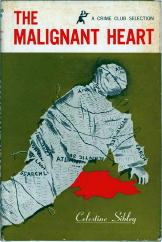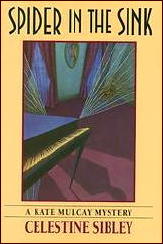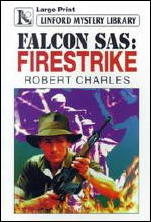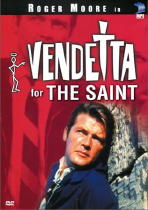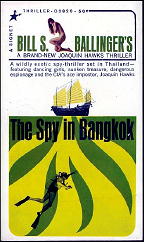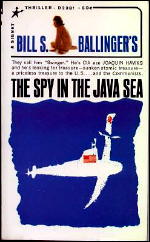December 2008
Monthly Archive
Mon 8 Dec 2008
CELESTINE SIBLEY – Ah, Sweet Mystery
Detective Book Club; hardcover reprint [3-in-1 edition]. First Edition: HarperCollins, 1991; paperback reprint, 1992.
It would take some investigating to be sure, but there may be record of sorts that was set with the publication of this book, Sibley’s second mystery novel. Atlanta newspaper reporter-columnist Kate Mulcay appeared in the first one, The Malignant Heart, which was published in 1958, and she’s in this one as well, only a mere 33 years later. (There may have been wider gaps between series appearances by a given character, but between the author’s first and second mystery, with the same character?)
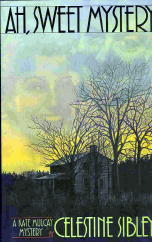
Sibley, also a newspaper columnist, also from Atlanta, was 74 when she wrote this one, and she went on to write four more Mulcay books, the final one in 1997, two years before she died.
Kate, now widowed in Ah, Sweet Mystery, is of an indeterminate age, but she’s still actively writing her columns and going along on a police raids. Hints of her life with her husband Benjy, a member of the Atlanta police force, suggest that he appeared in the first book, but Kate now lives on her own.
Dead is Garney Wilcox, a cutthroat real estate developer intent on transformed quiet corners of Atlanta and environs into apartment complexes. Confessing to the crime is his stepmother, Miss Willie, whom Garney had recently persuaded to abandon her long-time home for the comforts of a rundown nursing manor.
There are only a few mystery novels, I am sure, which incorporate the songs and mystique of Nelson Eddy and Jeannette MacDonald as part of the plot, but this is one of them. Also an underlying theme is the sense that pieces of traditional southern living and hospitality are disappearing, and that life in general in the South is changing. “Little enough country left,” Kate says on page 211. “I come this way if I have time.”
The mystery itself is not nearly as strong as the nice homey feeling that Sibley creates, giving Kate guidance as she seeks out the roots of true southern culture. Puzzling to me was the dead man, who seems to have been electrocuted as part of his travails, rubbing up against a raw wire in a house where the electricity has been cut off. And while the culprits seem fairly obvious, the actions of the dead man’s wife are unfathomable, or at least unexplained.
On the basis of a sample of size one, Sibley’s books, while sound as social statements and weak as detective novels, should still be more widely known than I think they are. (They’ve all come out as paperbacks, but I don’t think I’ve ever come across a used one.)
— December 2002 (slightly revised)
[UPDATE] 12-08-08. For the record, here’s a list of all of Celestine Sibley’s mystery fiction, thanks to the Revised Crime Fiction IV, by Allen J. Hubin. Kate Mulcay appears in all five:
SIBLEY, CELESTINE (1917-1999)
* The Malignant Heart. Doubleday 1958.
* Ah, Sweet Mystery. Harper 1991.
* Straight As an Arrow. Harper 1992.
* Dire Happenings at Scratch Ankle. Harper 1993.
* A Plague of Kinfolks. Harper 1995.
* Spider in the Sink. Harper 1997.
Mon 8 Dec 2008
WOMAN OF STRAW. United Artists, 1964. Gina Lollobrigida, Sean Connery, Ralph Richardson, Alexander Knox, Johnny Sekka. Based on the book by Catherine Arley (Collins Crime Club, UK, 1957; no US edition) previously published in France as La Femme de Paille in 1953. Director: Basil Dearden.
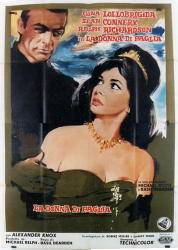
What you should do first is go to British mystery writer Martin Edwards’ blog, where he cited the book the film is based on as part of Patti Abbott’s “Forgotten Books” project on her blog. This is a joint enterprise in which every Friday people post suggestions of books worth being recognized again (or for the first time).
I hadn’t heard of either the book or the movie, but when I read Martin’s write-up and then I learned that Sean Connery and Gina Lollobrigida played the two of the three leading parts in the film, I couldn’t resist.
I haven’t ordered a copy of the book, but I was able to obtain a DVD of the movie version rather easily. Most of professional reviews have been negative (Variety and so on), but with one tiny qualification on my part, in my opinion most of the professional reviews are wrong. If you are a fan of detective fiction and if you ever come across a copy of this movie, by all means, don’t hesitate. Snap it up at once.
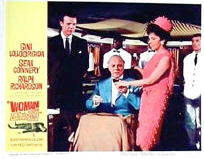
From Martin’s account, the book takes place in Germany, and the movie takes place in England (and Majorca), but from there, the basic plot line sounds the same.
When a wealthy old man with a world-hating disposition (Ralph Richardson) needs a nurse, his nephew who hates him and for good reason (Sean Connery) makes sure that the nurse he gets (Gina Lollobrigida) is the one that the nephew wants.
Mr. Connery (of course) has a plan.
Let me describe the wheelchair-bound uncle this way, using the nephew’s own words. “He treats his servants [black] as dogs, and his dogs as servants.” Nurse Maria resists the nephew’s plans for her at first, but 50 million dollars is very, very tempting. Nonetheless, her resistance — and eventually making him come to her, the uncle, that is, not her to him — is what eventually wins him over.
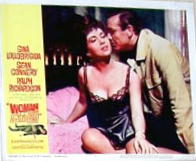
And believe it or not, her charm not only works on the nephew, as it has all along, but the uncle’s behavior seems to take a turn for the better as well.
I’d have to agree that wealthy (and unlikeable) people being murdered by relatives for their money is old hat stuff in detective fiction, and maybe this is what turned the professional reviewers off. That and the fact that it takes a long time to develop the characters with very little happening.
I didn’t mind it at all. Delicious! Sean Connery is super suave, Miss Lollabrigida is delectable with just a hint of naivete, and Ralph Richardson as an upper-crust man who’s unhappy with both life and wealth — it is a role he was born to play.
And when the expected event happens, it doesn’t happen the way I expected it to happen, and there’s no way I could have turned this movie off from that point on, no matter what. I was glued to the chair. Suspense? Yes, and I’m only sorry I can’t tell you more.
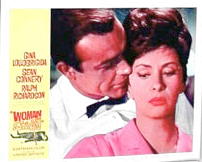
But I did mention a tiny qualification for my praise for this movie, and that’s the ending, which came a little too fast and seemed a little too pat to be totally satisfactory.
I may have to watch the movie all the way through again sometime, just to be sure, but I’ve already watched the ending twice, and no, I’m not really displeased.
It’s only a quibble, and a minor one. Other than that, I’m going to repeat myself, and recommend this highly as a Must See.
Sun 7 Dec 2008
I’ve been continuing with the alphabetized listings for the online Addenda for the Revised Crime Fiction IV, by Allen J. Hubin. I’m now in the C’s, as you may recall.
Note that many of these new listings are of film versions of stories and novels already included in CFIV. If such is the case, bibliographic details for the books themselves are omitted.
CHARLES, ROBERT. Pseudonym of Robert Charles Smith, 1938- . Other pseudonym: Charles Leader. Author of numerous spy and adventure novels included in the Revised Crime Fiction IV. Add the titles below, and SC: Capt. Mark Falcon = MF, for the two books so indicated.
Falcon SAS: Blood River. Linford pb, 1999. Setting: Borneo. MF
Falcon SAS: Firestrike. Linford pb, 1999 MF
Persons Reported. Linford pb, 2000
CHARLES, THERESA. Pseudonym of Irene Maude Mossop Swatridge, 1905-1988 & Charles John Swatridge, 1896-1964. Add birth and death dates. Under this name, the author of seven books published in the US as gothic romances. Other pseudonyms for Irene Swatridge: Leslie Lance & Jan Tempest. For a short discussion of this author’s books, see this earlier post on the Mystery*File blog.
CHARTERIS, LESLIE
The Saint Goes West. Show second film as: Lux, 1960, as Le Saint mène la danse, aka The Dance of Death (scw: Albert Simonin, Jacques Nahum, Yvan Audouard; dir: Nahum). SC: Simon Templar (Félix Marten).
Vendetta for the Saint. [ghostwritten by science fiction writer Harry Harrison] TV movie: ITC, 1969 (scw: Harry W. Junkin, John Kruse; dir: Jim O’Connolly). SC: Simon Templar (Roger Moore).
CHASE, JAMES HADLEY
My Laugh Comes Last. Film: MGM, 1995, as The Set Up (scw: Michael Thoma; dir: Strathford Hamilton)
CHASTAIN, THOMAS
Death Stalk. TV movie: Wolper, 1975 (scw: John W. Bloch, Stephen Kandel; dir: Robert Day)
CHESTER, PETER. Pseudonym of Dennis Phillips; other pseudonyms Simon Challis, Peter Chambers & Philip Daniels. As “Peter Chester,” the author of five mystery stories listed in the Revised Crime Fiction IV. A series character named Johnny Preston is in three of them, although not the one below. A British writer, Phillips was much prolific as “Peter Chambers.” Under this byline he wrote over 35 mystery and detective novels, many with American private eye Mark Preston. Whether Johnny Preston is also a PI is not known. Note that “Peter Chambers” is also the name of the PI who was one of US writer Henry Kane’s most frequent series characters.
The Traitors. Herbert Jenkins, UK, hc, 1964. Add setting: England
CHESTERTON, G. K. TV movie, based on the Father Brown stories: Marble Arch, 1979, as Sanctuary of Fear (scw: Don M. Mankiewicz, Gordon Cotler; dir: John Llewellyn Moxey). SC: Father Brown (Barnard Hughes)
CHILD, LEE. Add: Pseudonym of James D. Grant, 1954- . Born in England; studied law; living in NYC; TV director turned writer. Author of four “Jack Reacher” novels included in the Revised Crime Fiction IV through the year 2000; the series continues through the present day. Twelve have appeared so far, with a 13th scheduled for 2009. Reacher is a former Army MP officer who attracts trouble wherever he goes.
Sun 7 Dec 2008
Posted by Steve under
ReviewsNo Comments
REVIEWED BY TED FITZGERALD:
JAMES SALLIS – Drive. Poisoned Pen Press, hardcover, September 2005; Harvest Books, trade paperback, September 2006.
DUANE SWIERCZYNSKI – The Wheelman. St. Martins, hardcover, September 2005; trade paperback, November 2006.
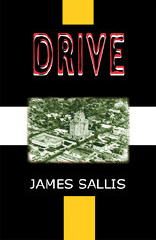
There are those who say that too many of us identity ourselves too much with our jobs. That’s certainly true of the protagonists of these two fast-moving novels.
Sallis’s lead character has simply taken the name Driver because that’s what does, both as a movie stunt driver and as a getaway specialist. Swierczynki’s Patrick Lennon is an apparently mute Irishman who harbors secrets even from the reader.
Both stories spin off from capers gone wrong. Indeed, could anyone write a novel about a caper that goes off without a hitch? And would anyone read it?
Sallis’s lean tale spins back and forth in time and ultimately leads to a point where Driver will have to decide whether he can still exist in the form he’s created or evolve into something else. If you get what I’m getting at, you know Sallis and you know this is as readable as it is speculative.
Good, lean, intriguing.
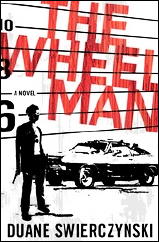
The Wheelman, on the other hand, speeds forth in the aftermath of a botched bank robbery and doesn’t stop until there’s virtually no one standing.
Patrick Lennon finds himself flailing about among a cross section of Philadelphia Mafioso, Russian gangsters and corrupt bottom feeders, none of whom are as clever as they think, most of whom are double-crossed by sharpies who are in turn double-crossed by even rougher scoundrels.
At first, I thought the book was going over the top but then it came gradually clear that this isn’t so much a hardboiled caper as it is a black comedy, one that ends with an appropriately bitter chuckle that could also be perceived as a death rattle.
Grand, nasty fun.
— Reprinted from
A Shoe in My Hand #9, November 2005.
Sun 7 Dec 2008
REVIEWED BY WALTER ALBERT:
HIGH TREASON. GB/Tiffany, 1929; Maurice Elvey, director; Benita Hume, Jameson Thomas, Humberston Wright, Basil Gill, James Carew, Judd Green, Milton Rosmer, Henry Vibart, Irene Rooke, Renee Ray. Shown at Cinecon 41, September 2005.
This was a science fiction film previously unknown to me and to, I suspect, a majority of the audience. Although it was filmed in both sound and silent versions, the sound track had decomposed, and only the silent version appears to survive.

Set in the mid-20th century, some twenty years after the date of the film’s release, it chronicles an explosive situation in which subversive capitalists and terrorists, working behind the scenes, are attempting to set off a war between the two major international powers represented by North America and Britain and continental governments.
(The writer of the program notes seems to think Britain and the US are a co-joined superpower even though the film makes it clear that Washington and London are the leaders of their respective alliances.)
This was released two years after the seminal German science fiction film, Metropolis. High Treason has none of the visionary power of Lang’s film but its simplistic view of the future city (airplanes landing on roofs, and TV) is somewhat compensated for by a plot which culminates with the murder of the leader who’s pushing for war by the world’s leading pacifistic in an attempt to derail the race toward disaster.
It’s certainly superior to the rather silly American SF film Just Imagine (1930) but it will not be until 1936 that Britain, with the release of Things to Come, will produce an important science fiction film.
Sun 7 Dec 2008
Posted by Steve under
Reviews1 Comment
ANNE PERRY – Funeral in Blue
Fawcett; paperback reprint, 1st printing, September 2002. Hardcover edition: Ballantine, 2001.
All that Victorian private enquiry agent James Monk can remember of his life are the last six years, his memory lost in a coach crash, but his abilities as a detective are still intact. This is the 12th of his cases to appear in book form, and the first that I’ve read. (Perry has also written at least 22 mysteries in which Thomas and Charlotte Pitt are the detectives. She is one prolific lady.)

Besides having a solid, almost palpable sense of time and place — London in September (always foggy) plus glorious, free-spirited Vienna — the story Perry tells is as complicated as any detection aficionado could possibly wish.
The wife of the doctor with whom Monk’s wife Hester works as a nurse for has been murdered. Her portrait was being painted, and her body is found in the artist’s studio, along with the artist’s live-in model. Once the artist has been eliminated from suspicion, Dr. Beck, as the husband, is the most obvious other suspect.
There is more to the story. Both Dr. Beck and his wife were young revolutionaries together in Vienna, fighting tyranny in the 1848 uprising, and failing, but after they also became lovers, they seem to have found their infatuation with each other fading, after 13 years of humdrum life in England. To track down clues about their hidden past, Monk is required to make a memorable trip to Austria, where he learns a great deal, but only a small hint of anything tangible to help in Beck’s defense.
Perry is a meticulous writer, with a great care to physical detail. It is therefore all the more puzzling when small glitches in the mystery itself appear. Small matters unknown to the reader are referred to before the facts are revealed by Monk in his investigation. And when what one witness says ignores what another has stated, it seems to go without notice — nor it is a clue that fits in place later, as an overly observant reader might suspect.
Worse, especially if you’re a fan of courtroom drama, Perry will have you turning the pages as fast you can, only to have Monk take the stand — but for the prosecution, which makes no sense at all, except for dramatic effect. The effect is powerful, but it wouldn’t, couldn’t have happened that way. (Could it?)
Net result: Funeral in Blue is an engrossing period novel, a small triumph of historical fiction, but it’s marred by a seemingly indifferent approach to mystery telling. This could easily have been a five star detective novel, with an ending as good as one of Agatha Christie’s, but it hits on only five cylinders, not six.
The book is still very much worth reading, but if you were to gather from my comments above that I was disappointed, you’d be right.
— December 2002 (slightly revised).
Sun 7 Dec 2008
GEORGE HARMON COXE – Murder for Two.
Dell #276; mapback edition; no date stated, but circa 1949. Hardcover edition: Alfred A. Knopf, 1943.
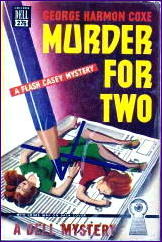
Another Boston mystery, this one featuring “Flashgun” Casey, ace photographer for the Express, but one of another style and another era. While Death of a Harvard Freshman [reviewed earlier here] was wordy and cerebral, this novel by George Harmon Coxe is terse and prone to violent action. Casey is as good with his fists as with his wits.
As you might have known without my saying so, had I mentioned earlier that this novel was originally published as a Black Mask serial. Its original title in the pulps? “Blood on the Lens.” [A three-part serial, beginning January 1943.]
And as far as titles go, Murder for Two is the more appropriate, even though it’s rather meager and bland in comparison. The first death is that of crusading columnist Rosiland Taylor. Apparently someone objected to a story she was working on. The second death is that of a former secretary who held some incriminating evidence against the target of that story.
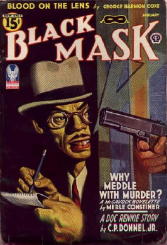
The case is all so straightforward that it comes as quite a pleasant (though not unexpected) surprise to learn that Coxe has more of a mystery in mind than that, so if you pick this one up and give it a try, don’t take it too lightly as a work of detective fiction. Keep reading. (The question is more of how Coxe is going to pull off what he does, not whether.) The key here is that there is a very nifty alibi involved, one so nifty, as a matter of fact, that no one is even aware it is an alibi.
Or in other words, there is a lot of action going on in this book, so take this as a warning. Coxe’s meticulous plotting can easily blindside you and catch you as flat-footed as I was. (A humbling admission to make, but there you are.)
He also catches a rare male camaraderie between Casey and police lieutenant Logan of Homicide — one that can suddenly flare into mutual irritation and tired sarcasm but then, with common sense and good humor, just as quickly right itself back into place again.
— From Mystery.File 1, January 1987 (revised).
Sat 6 Dec 2008
Posted by Steve under
ReviewsNo Comments
REVIEWED BY TED FITZGERALD:
STEPHEN KING – The Colorado Kid.
Hard Case Crime. Paperback original; first printing, October 2005.

Let me be the first to state that the authorial specter hovering over Stephen King’s latest is none other than George V. Higgins.
Maybe it’s being from New England, but starting with the long monologue about why the Boston Globe reporter’s money is being slipped to the waitress, and in a clandestine fashion, and then recognizing that the book is one long alternating monologue among two aging Maine newspapermen attempting to instruct their young intern on the nature of mystery and the mystery of life, well, this is the sort of thing Higgins did in many of his books.
And this slim volume succeeds as lecture, meditation and tall tale. Its brevity works in its favor. Any longer and it would get caught up in itself.
Basically, this is the story of two old codgers enticing a young would-be reporter with the sort of sour wisdom old time newshounds expel with the ease and frequency they break wind: Kid, there are some things for which there are no answers, some mysteries that will never be solved.
Want closure? Write fiction. This book is a creative gamble for King and a marketing gamble for Hard Case, and I applaud them both for trying.
It’s not Hard Case’s usual type of book (except for the cover) although, when all is said and done, it’s very much an old fashioned paperback original in its brevity and smooth, swift, readability.
— Reprinted from
A Shoe in My Hand #9, November 2005.
Sat 6 Dec 2008
GUNFIGHT AT THE O.K. CORRAL. Paramount, 1957. Burt Lancaster, Kirk Douglas, Rhonda Fleming, Jo Van Fleet, John Ireland, Lyle Bettger, Frank Faylen, Earl Holliman. Vocals: Frankie Laine. Screenwriter: Leon Uris; director: John Sturges.
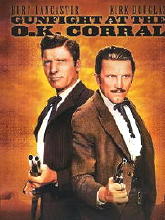
As a technicolor movie running just over two hours in length, this was a true western epic at the time it was released, and if it isn’t considered one now, it isn’t the fault of either of the two leading stars.
Burt Lancaster plays Wyatt Earp, straight and narrow to the core, and Kirk Douglas is in fine boisterous mettle as Doc Holliday, dying of TB and therefore unafraid of any man with a gun, and (as they say) untameable by any woman (Jo Van Fleet, as the much-abused Kate Fisher). And here lies an early cinematic revelation, perhaps, that a western hero’s deeds need not always be heroic.
But the events of the O. K. Corral are what everyone who watches this movie is going to be waiting for. Don’t expect either historical accuracy or intelligence on part of the Clantons and their gang, including Johnny Ringo (the always menacing John Ireland). Along the way we get a bit of romance between Wyatt and a gambler lady named Laura Denbow (the beautiful redheaded Rhonda Fleming) but I noticed no particular sparks flying.
No sir or ma’am, Kirk Douglas is the star of this show, tagging along as he does with Wyatt as the latter takes his lawmaking abilities from town to town, and a rough craggy friendship, even respect, gradually develops. And that’s the story as far as I was concerned. Friendships, even craggy ones, are never to be shunned. (Getting up from a sick bed to face the Clantons with me, as does Doc, that’s a bonus I wouldn’t ask of anyone.)
Sat 6 Dec 2008
BILL S. BALLINGER – Not I, Said the Vixen
Gold Medal k1529; paperback original, 1965.
Ballinger had a long career as a mystery writer as well as working for television and the movies, but for some strange reason, this is the first book of his I’ve read. So, whether this one is any way typical or non-typical of his fiction, I couldn’t tell you.
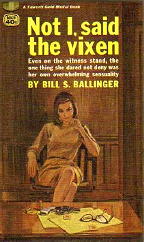
His one-time protagonist in this largely courtroom affair is Cyrus March, perhaps the best defense attorney in the country. But unlike Perry Mason, say, March also has a drinking problem. And somewhat unlike Perry Mason, his client admits to pulling the trigger in the fatal shooting of a wealthy female socialite.
Like so many of Perry Mason’s clients, Cyrus March’s is a beautiful woman, perhaps even narcissistic, and her story is that the victim was an unknown intruder in her apartment. March’s problems with the bottle began with the death of his wife, and unlike Perry Mason, he soon declares his love for person he’s defending.
The dialogue is sometimes stilted, and the action often stagy, but every once in a while Ballinger mixes in a brilliant turn of phrase that makes you remember why you’d rather be reading instead of watching the tube. He also alternates chapters between first and third person, an unusual format that doesn’t quite click, even though you know why he’s using it.
Lesbianism is a key ingredient of what makes the courtroom drama go — it’s seemingly kept at arm’s length at first, but the nuances become less and less subtle as the story works its way out.
Rather a minor effort overall, but if you ever find a copy to read, I think it’ll keep you interested all the way through. It did me, and sometimes that’s all you need.
[UPDATE] 12-05-08. Out of curiosity, I checked again to see if Cyrus March showed up in any of Ballinger’s other mystery fiction, but I’ve found nothing to suggest that he did. Ballinger did have a series character named Joaquin Hawks, who was in five paperback originals put out by Signet in the two year period 1965-66.
As a Native American detective, tribal affiliation unknown, Hawks is mentioned in my list of N.A. sleuths on the primary M*F website, but I’ve not read any of his adventures. Another website says that he “is a case officer in the Central Intelligence Agency. His normal beat is Southeast Asia.”
If you follow that last link, you’ll find a lot more information about him. For the record, here’s a list of all five of the Joaquin Hawks books, expanded from the Revised Crime Fiction IV, by Allen J. Hubin:
HAWKS, JOAQUIN:
The Spy in the Jungle (n.) Signet D2674, pbo, May 1965 [Viet Nam]
The Chinese Mask (n.) Signet D2715, pbo, June 1965 [China]
The Spy in Bangkok (n.) Signet D2820, pbo, Dec 1965 [Thailand]
The Spy at Angkor Wat (n.) Signet D2899, pbo, May 1966 [Cambodia]
The Spy in the Java Sea (n.) Signet D2981, pbo, Sept 1966 [Far East]
« Previous Page — Next Page »

